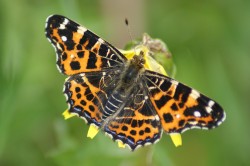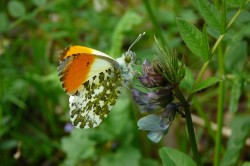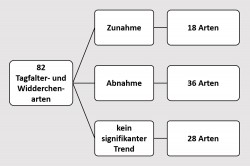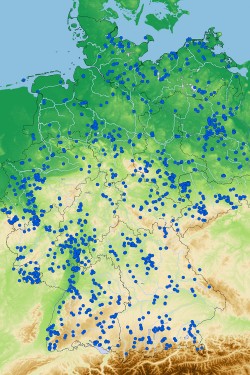Press Release, 10. March 2025
An insect census: 20 years of butterfly monitoring in Germany
Workshop and anniversary celebration at the UFZ
For 20 years, dedicated volunteers have been active throughout Germany to record the occurrence of these popular insects. This "Butterfly Monitoring Germany" (TMD) project was launched in 2005 by scientists from the Helmholtz Centre for Environmental Research (UFZ) and members of the Society for Butterfly Conservation (GfS). This project has since provided much valuable information, not only about the butterfly world, but also about how land use and climate change are changing the state of nature as a whole. To mark the anniversary, a celebration will be held on 15 March 2025 following the butterfly workshop, which brings together over 200 butterfly experts from all over Germany at the UFZ once every year.

Photo: Elisabeth Rieger

Photo: Werner Messerschmid

Photo: UFZ

Photo: Map is based on TOPO-WMS by Mundialis & ©OpenStreetMap Contributors
"Life alone is not enough," said the butterfly. "One must also have sunshine, freedom and a little flower." What Hans Christian Andersen put into the mouth of his fluttering protagonist may sound a little too modest from a modern perspective. But the Dane was not an ecologist; he was a poet and fairy tale author. He didn't necessarily realise that butterflies are also dependent on an intact habitat and suitable climatic conditions.
And this is exactly what is increasingly lacking. But what consequences do rising temperatures and changes in land use have for biodiversity? We can now answer questions like this much better for butterflies than for most other insects. A highly successful project, celebrating its 20th anniversary in March 2025, has contributed to this: The "Butterfly Monitoring Germany" (TMD) project. In this project, hundreds of citizens are out and about between April and September every year, gathering information on the occurrence and abundance of these animals. They regularly walk a fixed route of up to one kilometre in length and use a standardised procedure to record all diurnal butterflies and moths they encounter along the way.
One of the founding fathers is agro-ecologist Prof. Josef Settele, who is a butterfly expert at the UFZ and chairman of the GfS. A few other countries have had such projects for a long time, especially in the UK, where volunteer butterfly counting has a long tradition: The "UK Butterfly Monitoring Scheme" has been in existence since 1976. However, the Netherlands has also had good experience with the "Landelijk Meetnet Dagvlinders", which was launched in 1991. So why not organise a nationwide butterfly census in Germany too?
Together with the Society for Butterfly Conservation (GfS), the UFZ therefore launched a corresponding initiative in 2005 with the German Federation for the Environment and Nature Conservation (BUND) and ZDF (National German Television) as project partners. This project broadcast detailed information and an appeal for participation under the slogan "Butterfly Adventure" - with a clear success.
TMD - one of the most successful long-term monitoring projects with volunteer researchers in Germany
Since the start of butterfly monitoring, nearly 4.4 million butterflies have been counted on a total of 1,620 counting routes, known as transects. The volunteer researchers have covered nearly 55,000 kilometres in over 130,000 inspections along their counting routes. Every year, they walk roughly 600 transects throughout Germany. They include a wide range of people - from school classes to 94-year-old senior citizens. Although the majority are over 50, the project has no worries about recruiting new talent. But of course, simply advertising is not enough; the participants also have to be supported in their work. "It was very important for our success that we had the biologist Elisabeth Kühn as a permanent UFZ contact person for the counters right from the start," stresses Josef Settele. As project coordinator, she ensures that interested parties receive the necessary information and that questions are answered quickly. Training is also organised for groups. The butterfly workshops, which the UFZ team and the Society for Butterfly Conservation (GfS) have organised every spring in Leipzig since 1999 and which are open to all interested parties, are also well received. The same is the case for the annual reports and newsletters that Elisabeth Kühn regularly produces and sends out. Among other things, it reports on scientific publications based on the TMD data. In their experience, such professional feedback is very important in motivating the counters in the long term: "People want to see that their involvement is meaningful and that we really do something with their data."
The relevance of the volunteer-collected data for science is now undisputed. Universities and research institutions simply do not have sufficient staff or funding available for this work. And concerns regarding the quality of the data have long since been dispelled. This is because it has become clear that the level of expertise among all participants is enormous. The automatic quality control in conjunction with data verification by UFZ scientists usually detects any occasionally incorrectly identified butterfly.
Butterflies as indicators / results and trends
Butterflies are very good indicators of environmental changes. This is because many of them have highly specific requirements for the climate and vegetation in their habitat. As soon as something starts to change, they react immediately: Because a generation of butterflies usually only lives for a few months to a maximum of one year and needs correspondingly little time to reproduce, populations often grow or shrink relatively quickly. "However, we have to bear in mind that the abundance can also undergo significant natural fluctuation," says Josef Settele. It is not necessarily an alarm signal if the occurrence of a species declines for two or three years. To detect true trends, you have to collect data for decades - and in as many areas as possible.
The information from twenty years of butterfly monitoring is therefore not yet sufficient to assess the population development of all butterflies. But in many cases, it's already enough. "We record roughly 120 of the 178 butterfly species that are considered established in Germany. The rest are so rare or occur in such special habitats or regions (such as only in the Alps) that they could not yet be included in the analysis," says Elisabeth Kühn. "And for 82 butterfly species, the data are good enough to calculate trends."
The results are not particularly positive. Some warmth-loving species such as the Wall Brown, the Small Pearl-bordered Fritillary and the Orange Tip are on the rise. However, considering the development of all species, the transect data indicate an overall downward trend: "18 species are increasing, 28 species have maintained their level and 36 species are decreasing," summarises Josef Settele. However, it must be borne in mind that the species whose populations have increased are more widespread species. It has not yet been possible to analyse many specialist species that may be far worse off.
Trend calculations are now also available for many countries. Roughly 6,000 volunteer butterfly counters are active throughout Europe. As they apply the same methodology, the data are comparable and can also be used to visualise Europe-wide developments in the butterfly world.
Impact in politics
Trends can be calculated not only for individual species, but e.g. also for all the species of specific habitats. This is precisely the idea behind the "Grassland Butterfly Index". On a European scale this index is calculated based on monitoring data from projects including Butterfly Monitoring Germany (TMD) and reflects the relative population trends of 17 typical inhabitants of meadows and pastures. If the positive and negative trends in these species roughly balance each other out, the indicator remains at the same level. If more species decline than increase in the same period, the value decreases - and vice versa. Lower values therefore mean greater problems for the grassland inhabitants. "This indicator clearly shows how land use in particular affects biodiversity," says Elisabeth Kühn.
This will play a very important role on the European level in the future. The Nature Restoration Regulation (NRR), which was adopted by a narrow majority in the EU Ministerial Council in June 2024, sets binding goals for the restoration of various ecosystems throughout the EU. Two years after the regulation enters into force, member states must submit plans on how they intend to meet these targets. They must also document the success of their measures.
However, the latter is not so easy. So far, there are only a few indicators that can reliably show the state of biodiversity. The regulation provides for three of these: The supply of organic carbon in arable soils and the structural diversity of the landscape (as indirect indicators) and, as the only direct indicator, because it is specifically orientated towards species, the "Grassland Butterfly Index" that also incorporates the TMD data. "This is a real success story for us," says Josef Settele. "It is very rare that project results lead to the enactment of a law."
More information:
Celebration programme: https://www.ufz.de/export/assets/1d37e704b6a63ab0a4ead1d70ccdb35a5d320d46.pdf
Further information
Elisabeth Kühn
UFZ Department of Conservation Biology & Social-Ecological Systems / TMD coordination
elisabeth.kuehn@ufz.de
Prof. Dr. Josef Settele
Head of UFZ Department of Conservation Biology & Social-Ecological Systems
josef.settele@ufz.de
UFZ press office
Susanne Hufe
Phone: +49 341 6025-1630
presse@ufz.de
In the Helmholtz Centre for Environmental Research (UFZ), scientists conduct research into the causes and consequences of far-reaching environmental changes. Their areas of study cover water resources, ecosystems of the future, environmental technologies and biotechnologies, the effects of chemicals in the environment, modelling and social-scientific issues. The UFZ employs more than 1,100 staff at its sites in Leipzig, Halle and Magdeburg. It is funded by the Federal Government, Saxony and Saxony-Anhalt.
www.ufz.deThe Helmholtz Association contributes to solving major challenges facing society, science and the economy with top scientific achievements in six research fields: Energy; Earth and Environment; Health; Key Technologies; Matter; and Aeronautics, Space and Transport. With some 39,000 employees in 19 research centres, the Helmholtz Association is Germany’s largest scientific organisation.
www.helmholtz.de